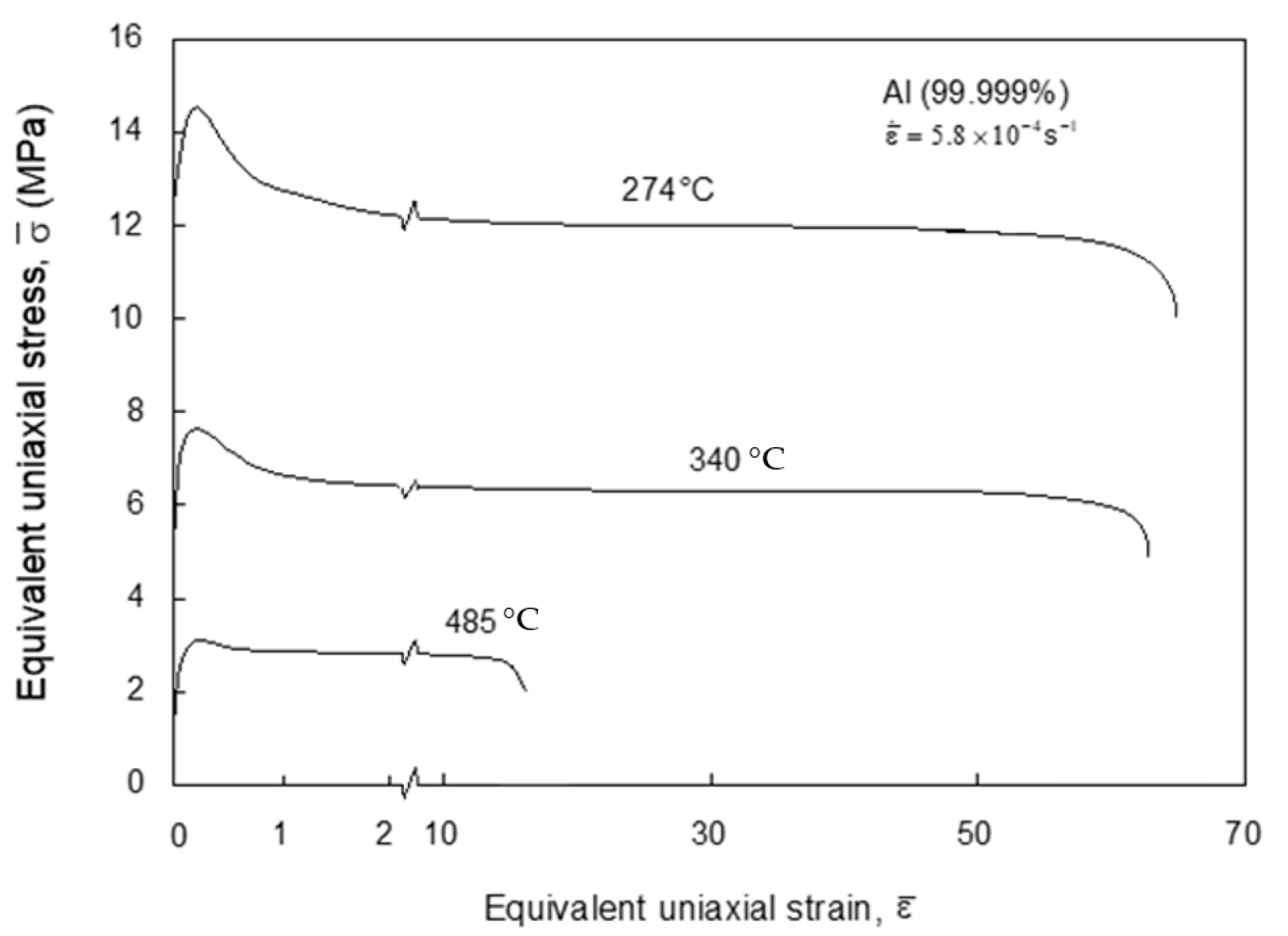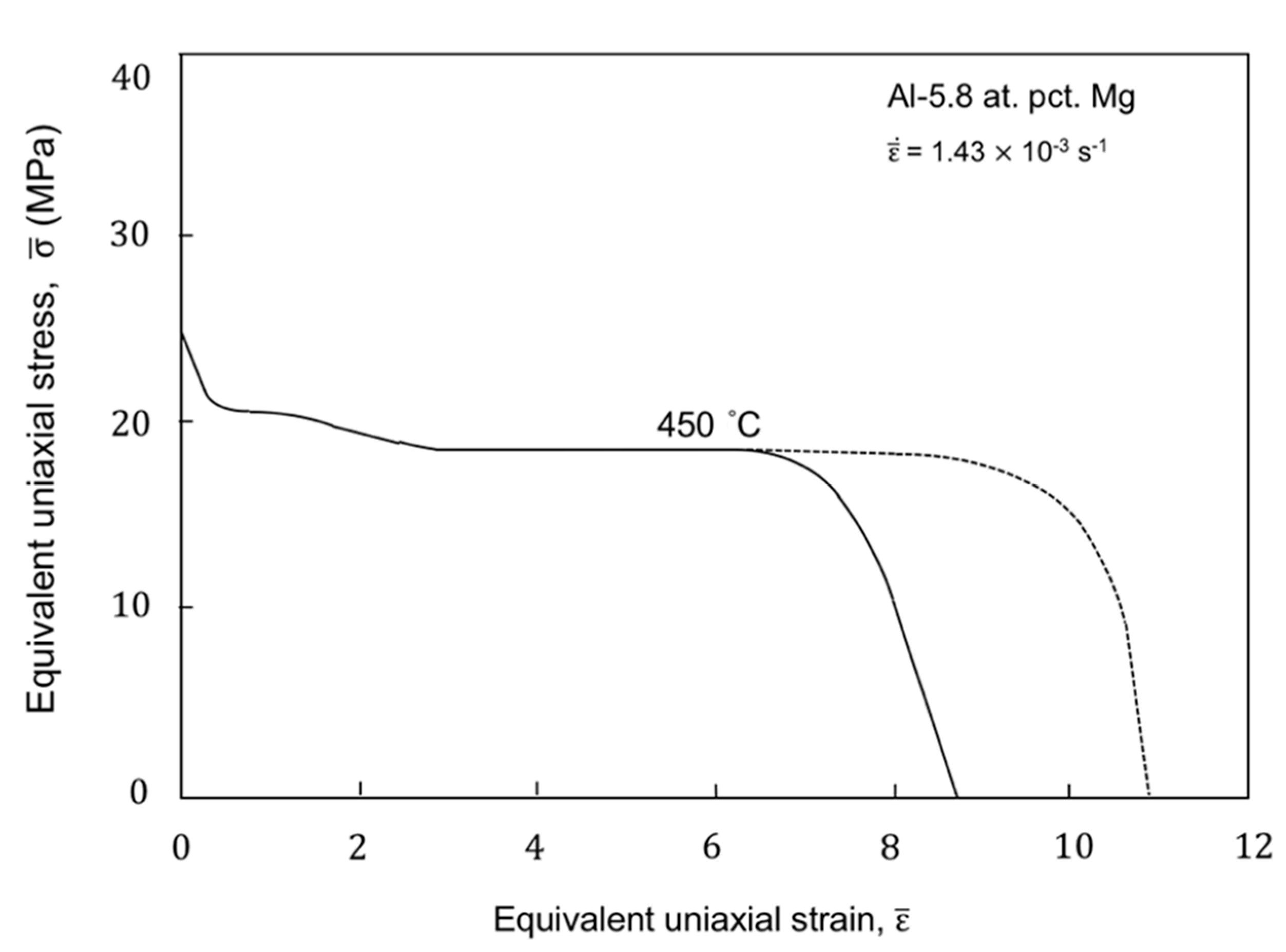Large-Strain Softening of Metals at Elevated Temperatures by Deformation Texture Development
Abstract
:1. Introduction
2. Discussion
3. Conclusions
Author Contributions
Funding
Institutional Review Board Statement
Informed Consent Statement
Data Availability Statement
Acknowledgments
Conflicts of Interest
References
- Kassner, M.E.; McMahon, M.E. The dislocation structure of aluminum. Metall. Mater. Trans. A 1987, 18, 835–846. [Google Scholar] [CrossRef]
- Kassner, M.E.; Myshlyaev, M.M.; McQueen, H.J. Large-strain torsional deformation in aluminum at elevated temperatures. Mater. Sci. Eng. 1989, 108, 45–61. [Google Scholar] [CrossRef]
- Perdrix, C.; Perrin, M.Y.; Montheillet, F. Comportement mecanique et evolution structural de l’aluminium au cours d’une deformation a chaud de grande amplitude. Mem. Etud. Sci. Rev. Metall. 1981, 78, 309–320. [Google Scholar]
- McQueen, H.J.; Knustad, O.; Ryum, N.; Solberg, J.K. Microstructural evolution in Al deformed to strains of 60 at 400 °C. Scr. Metall. 1985, 19, 73–78. [Google Scholar] [CrossRef]
- McQueen, H.J.; Solberg, J.K.; Ryum, N.; Nes, E. Evolution of flow stress in aluminum during ultra-high straining at elevated temperatures. Philos. Mag. A 1989, 60, 473–485. [Google Scholar] [CrossRef]
- Henshall, G.A.; Kassner, M.E.; McQueen, H.J. Dynamic restoration mechanisms in Al-5.8 at % Mg deformed to large strains in the solute drag regime. Metall. Trans. A 1992, 23, 881–889. [Google Scholar] [CrossRef]
- Schmidt, C.G.; Young, C.M.; Walser, B.; Klundt, R.H.; Sherby, O.D. The influence of substructure on the elevated and room temperature strength of 26Cr-1Mo ferritic stainless steel. Metall. Trans. A 1982, 13, 447–456. [Google Scholar] [CrossRef]
- Kassner, M.E.; Barrabes, S. New developments in geometric dynamic recrystallization. Mater. Sci. Eng. A 2005, 410, 152–155. [Google Scholar] [CrossRef]
- Perez-Prado, M.T.; Barrabes, S.R.; Kassner, M.E.; Evangelista, E. Dynamic restoration mechanisms in a-zirconium at elevated temperatures. Acta Mater. 2005, 53, 581–591. [Google Scholar] [CrossRef]
- Kassner, M.E.; Campbell, C.S.; Ermagan, R. Large strain softening in aluminum in pure shear at elevated-temperatures: Influence of dislocation climb. Metall. Mater. Trans. 2017, 48, 3971–3974. [Google Scholar] [CrossRef]
- Kassner, M.E. Fundamentals of Creep in Metals and Alloys, 3rd ed.; Elsevier Ltd.: Amsterdam, The Netherlands, 2015. [Google Scholar]
- Kassner, M.E.; Pollard, J.; Evangelista, E.; Cerri, E. Restoration Mechanisms in Large-Strain Deformation of High Purity Aluminum at Ambient-Temperature, and the Determination of the Existence of a Steady State. Acta Metall. Mater. 1994, 42, 3223–3230. [Google Scholar] [CrossRef]
- Kassner, M.E.; McQueen, H.J.; Pollard, J.; Evangelista, E.; Cerri, E. Restoration mechanisms in large-strain deformation of high purity aluminum at ambient temperature. Scr. Metal. Mater. 1994, 31, 1331–1336. [Google Scholar] [CrossRef]
- Kassner, M.E. Large-strain deformation of aluminum single crystals at elevated temperature as a test of the geometric-dynamic-recrystallization concept. Metall. Trans. A 1989, 20, 2182–2185. [Google Scholar] [CrossRef]
- Gourdet, S.; Montheillet, F. A model of continuous dynamic recrystallization. Acta Mater. 2003, 51, 2685–2699. [Google Scholar] [CrossRef]
- Storojeva, L.; Ponge, D.; Kaspar, R.; Raabe, D. Development of microstructure and texture of medium carbon steel during heavy warm deformation. Acta Mater. 2004, 52, 2209–2220. [Google Scholar] [CrossRef] [Green Version]
- Hayes, T.A.; Kassner, M.E.; Rosen, R.S. Steady-State Creep of α-Zirconium at Temperatures up to 850 °C. Metall. Mater. Trans. A 2002, 33, 337–344. [Google Scholar] [CrossRef] [Green Version]
- Hayes, T.A.; Kassner, M.E. Creep of Zirconium and Zirconium Alloys. Metall. Mater. Trans. A 2006, 37, 2389–2396. [Google Scholar] [CrossRef]
- Kassner, M.E. The rate dependence and microstructure of high-purity silver deformed to large strains between 0.16 Tm and 0.30 Tm. Metall. Trans. A 1990, 20, 2001–2010. [Google Scholar] [CrossRef]
- Kassner, M.E.; Wang, M.Z.; Perez-Prado, M.-T.; Alhajeri, S. Large-strain softening of aluminum in shear at elevated temperature. Metall. Mater. Trans. A 2002, 33, 3145–3154. [Google Scholar] [CrossRef]
- Kuzmin, S.L.; Likhachev, V.A.; Myshlyaev, M.M.; Nickonov, Y.A.; Senkov, O.N.; Zhdanov, A.A. Superplasticity in Al single crystals. Scr. Metall. 1978, 12, 735–736. [Google Scholar] [CrossRef]
- Pettersen, T.; Nes, E. On the origin of strain softening during deformation of aluminum in torsion to large strains. Metall. Mater. Trans. A 2003, 34, 2727–2736. [Google Scholar] [CrossRef]
- Kassner, M.E.; Nguyen, N.Q.; Henshall, G.A.; McQueen, H.J. The effects of temperature and strain rate on extended ductility of aluminum. Mater. Sci. Eng. A 1991, 132, 97–105. [Google Scholar] [CrossRef]
- McQueen, H.J. ICOTOM 12; Spunar, J.A., Ed.; NRC Research Pub.: Ottawa, ON, Canada, 1999; pp. 836–841. [Google Scholar]
- Sanchez, P.; Pochettino, A.; Chauveau, T.; Bacroix, B. Torsion texture development of zirconium alloys. J. Nuc. Mater. 2001, 298, 329–339. [Google Scholar] [CrossRef]
- Perez-Prado, M.-T.; IMEDA, Madrid, Spain. Private communication, 2021.
- Ardell, A.J.; Sherby, O.D. The steady-state creep of polycrystalline alpha zirconium at elevated temperatures. Trans. Metall. Soc. Am. Inst. Min. Metall. Pet. Eng. 1967, 239, 1547–1556. [Google Scholar]





Publisher’s Note: MDPI stays neutral with regard to jurisdictional claims in published maps and institutional affiliations. |
© 2021 by the authors. Licensee MDPI, Basel, Switzerland. This article is an open access article distributed under the terms and conditions of the Creative Commons Attribution (CC BY) license (https://creativecommons.org/licenses/by/4.0/).
Share and Cite
Kassner, M.E.; Ermagan, R. Large-Strain Softening of Metals at Elevated Temperatures by Deformation Texture Development. Metals 2021, 11, 1059. https://doi.org/10.3390/met11071059
Kassner ME, Ermagan R. Large-Strain Softening of Metals at Elevated Temperatures by Deformation Texture Development. Metals. 2021; 11(7):1059. https://doi.org/10.3390/met11071059
Chicago/Turabian StyleKassner, Michael E., and Roya Ermagan. 2021. "Large-Strain Softening of Metals at Elevated Temperatures by Deformation Texture Development" Metals 11, no. 7: 1059. https://doi.org/10.3390/met11071059
APA StyleKassner, M. E., & Ermagan, R. (2021). Large-Strain Softening of Metals at Elevated Temperatures by Deformation Texture Development. Metals, 11(7), 1059. https://doi.org/10.3390/met11071059






